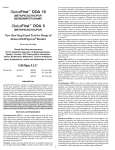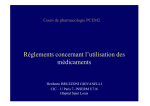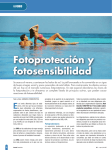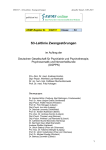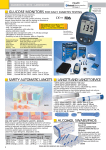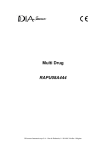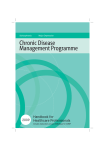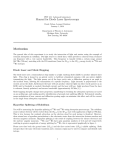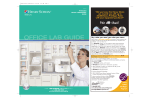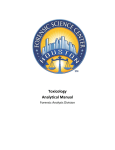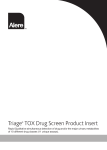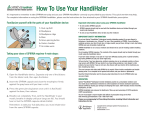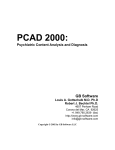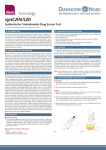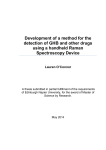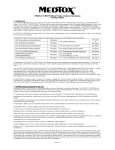Download SalivaScan Product Insert - Narcotic Testing Supplies & Equipment
Transcript
GLOSSARY OF SYMBOLS Catalog number Consult instructions for use Manufacturer Temperature limitation Batch code Use by Do not reuse Do not use if package is damaged Sufficient for (quantity) Authorized representative in the European Community NOTE: The following instructions pertain only to devices that contain an alcohol test strip. Saliva Alcohol Test Intended Use The Saliva Alcohol Test is a rapid, highly sensitive method to detect the presence of alcohol in saliva and provide an approximation of relative blood alcohol concentration. This test provides a preliminary screen only. A more specific alternate chemical method must be used in order to obtain a confirmed analytical result. Clinical consideration and professional judgment should be applied to any test screen result, particularly when preliminary positive screens are indicated. Summary Two-thirds of all adults drink alcohol.¹ The blood alcohol concentration at which a person becomes impaired is variable dependent upon the individual. Each individual has specific parameters that affect the level of impairment such as size, weight, eating habits and alcohol tolerance. Inappropriate consumption of alcohol can be a contributing factor to many accidents, injuries, and medical conditions. Principle It is well established that the concentration of alcohol in saliva is comparable to that of blood.2,3 The Saliva Alcohol Test consists of a plastic strip with a reaction pad attached at the tip. On contact with solutions of alcohol, the reaction pad will rapidly turn colors depending on the concentration of alcohol present. The pad employs a solid-phase chemistry which uses a highly specific enzyme reaction. Reagents • Tetramethylbenzidine • Alcohol Oxidase (EC 1.1.3.13) • Peroxidase (EC 1.11.1.7) • Other additives Precautions The Saliva Alcohol Test is a visually interpreted test where color matching is used to provide an approximation of relative blood alcohol concentration. Test materials that have been exposed to saliva should be treated as potentially infectious. Do not use the One Step Saliva Alcohol Test after the expiration date marked on the foil package. Storage and Stability The Saliva Alcohol Test is to be stored at 2-27°C (36-80°F) in its sealed foil package. If storage temperatures exceed 27°C, the test performance may degrade. If the product is refrigerated, the Saliva Alcohol Test must be brought to room temperature prior to opening the pouch. Materials Provided • 25 Individually foil pouched test devices • Package insert Materials Required But Not Provided • Timer Directions For Use Allow the pouched strip to equilibrate to room temperature (15-27°C) prior to testing. 1. Abstain from placing anything in the mouth for fifteen (15) minutes prior to beginning the test. This includes non-alcoholic drinks, tobacco products, coffee, breath mints and food, etc. 2. Open the foil package and remove the device. Observe the reactive pad on the end of the test strip. If the reaction pad has a blue color before applying saliva sample, do not use. 3. For specimen collection, follow Procedure instructions on page 2 of this package insert. 4. Saturate the reactive pad with saliva. (It usually takes 6-8 seconds to be saturated.) Start timer immediately after saliva application. Read result at two (2) minutes. Compare the color of the reaction pad with the color chart provided to determine the relative blood alcohol level. Interpretation of Results Positive: The Saliva Alcohol Test will produce a color change in the presence of saliva alcohol. The color will range from light blue color at 0.02% relative blood alcohol concentration to a dark blue color near 0.30% relative blood alcohol concentration. Color pads are provided within this range to allow an approximation of relative blood alcohol concentration. The test may produce colors that appear to be between adjacent color pads. NOTE: The Saliva Alcohol Test is very sensitive to the presence of alcohol. A blue color that is lighter than the 0.02% color pad should be interpreted as being positive to the presence of alcohol in saliva but less than 0.02% relative blood alcohol. Negative: When the Saliva Alcohol Test shows no color change this should be interpreted as a negative result indicating that alcohol has not been detected. Invalid: If the color pad has a blue color before applying saliva sample, do not use the test. NOTE: A result where the outer edges of the color pad produces a slight color but the majority of the pad remains colorless the test should be repeated to ensure complete saturation of the pad with saliva. The test is not reusable. Limitations 1. Failure to wait 15 minutes after placing food, drink, or other materials (including smoking) in the mouth before running the test can produce erroneous results due to possible contamination of the saliva by interfering substances. 2. The Saliva Alcohol Test is highly sensitive to the presence of alcohol. Alcohol vapors in the air are sometimes detected by the Saliva Alcohol Test. Alcohol vapors are present in many institutions and homes. Alcohol is a component in many household products such as disinfectant, deodorizers, perfumes, and glass cleaners. If the presence of alcohol vapors is suspected, the test should be performed in an area known to be free of vapors. 3. Ingestion or general use of over-the-counter medications and products containing alcohol can produce positive results. Performance Characteristics The detection limit on the Saliva Alcohol Test is from 0.02% to 0.30% for approximate relative blood alcohol level. The cutoff level of the Saliva Alcohol Test can vary based on local regulations and laws. Test results can be compared to reference levels with color chart on the foil package. Assay Specificity The Saliva Alcohol Test will react with methyl, ethyl and allyl alcohols. Interfering Substances The following substances may interfere with the Saliva Alcohol Test when using samples other than saliva. The named substances do not normally appear in sufficient quantity in saliva to interfere with the test. A. Agents which enhance color development • Peroxidases • Strong oxidizers B. Agents which inhibit color development • Reducing agents: Ascorbic acid, Tannic acid, Pyrogallol, Mercaptans and tosylates, Oxalic acid, Uric Acid. • Bilirubin • L-dopa • L-methyldopa • Methampyrone Controls The Saliva Alcohol Test may be qualitatively verified by using a test solution prepared by adding 5 drops of 80 proof distilled spirits to 8 oz. (1 cup) of water. This solution should produce a color reaction on the pad. The color reaction with alcohol in saliva is somewhat slower and less intense than with alcohol in an aqueous solution. Bibliography SalivaScan™ For In Vitro Diagnostic Use INTENDED USE The DrugCheck® SalivaScan™ Oral Fluid Drug Test is a rapid visual immunoassay for the qualitative, presumptive detection of drugs of abuse in human oral fluid specimens. The test system consists of one or two membrane strips mounted in a plastic cassette. This test detects combinations of the following drugs at the concentrations listed below. Specific combinations will vary according to the test in question: Test Amphetamine (AMP) Benzodiazepine (BZO) Buprenorphine (BUP) Cocaine (COC) Cotinine (COT) EDDP (EDDP) Calibrator D-Amphetamine Oxazepam Buprenorphine Benzoylecgonine Cotinine 2-Ethyliden-1,5-Dimethyl3,3-Diphenylpyrrolidine Ketamine (KET) Ketamine Marijuana (THC) 11-nor-D9-THC-9 COOH Marijuana (THC) D9-THC Methadone (MTD) Methadone Methamphetamine (MET) D-Methamphetamine Opiates (OPI) Opiates Oxycodone (OXY) Oxycodone Phencyclidine (PCP) Phencyclidine Propoxyphene (PPX) Propoxyphene Barbiturate (BAR) Barbiturate Cut-off (ng/mL) 50 10 5 20 50 20 50 12 50 30 50 40 40 10 50 50 PRINCIPLE The DrugCheck SalivaScan is an immunoassay based on the principle of competitive binding. Drugs that may be present in the oral fluid specimen compete against their respective drug conjugate for binding sites on their specific antibody. During testing, a portion of the oral fluid specimen migrates upward by capillary action. A drug, if present in the oral fluid specimen below its cut-off concentration, will not saturate the binding sites of its specific antibody. The antibody will then react with the drug-protein conjugate and a visible colored line will show up in the test line region (T) of the specific drug strip. The presence of drug above the cut-off concentration in the oral fluid specimen will saturate all the binding sites of the antibody. Therefore, the colored line will not form in the test line region. A drug-positive oral fluid specimen will not generate a colored line in the specific test line region of the strip because of drug competition, while a drug-negative oral fluid specimen will generate a line in the test line region because of the absence of drug competition. To serve as a procedural control, a colored line will always appear at the control line region (C), indicating that proper volume of specimen has been added and membrane wicking has occurred. MATERIALS Materials Provided • Individually packed screening devices and oral fluid collection swabs • Combined Test Procedure/Results Record sheet • Package insert 1. Volpicellim, Joseph R., M.D., Ph.D.: Alcohol Dependence: Diagnosis, Clinical Aspects and Biopsychosocial Causes., Substance Abuse Library, University of Pennsylvania, 1997. 2. Jones, A.W.: Inter-and intra individual variations in the saliva/blood alcohol ratio during ethanol metabolism in man., Clin. Chem. 25, 1394-1398, 1979. 3. MaCall, L.E.L., Whiting, B., Moore, M.R. and Goldberg, A.: Correlation of ethanol concentrations in blood and saliva., Clin.Sci., 56, 283-286, 1979. Express Diagnostics Int’l, Inc.CEPartner4U 1550 Industrial DriveEsdoornlaan 13 Blue Earth, MN 56013 USA 3951 DB Maarn The Netherlands DC202I-INT March 2012 Materials Required but Not provided • Timer • Positive and negative controls INTRODUCTION The DrugCheck SalivaScan for AMP/BAR/BUP/BZO/COC/COT/EDDP/ KET/MET/MOR/ MTD/OXY/PCP/PPX/THC parent/THC and metabolites is a rapid,oral fluid screening test that can be performed without the use of an instrument. The test utilizes monoclonal antibodies to selectively detect elevated levels of specific drugs in human oral fluid. Amphetamine(AMP): Amphetamines (amphetamine, methamphetamine, and the structurally related “designer” drugs, e.g., “Ecstasy”) are sympathomimetic amines whose biological effects include potent central nervous system (CNS) stimulation, anorectic, hyperthermic, and cardiovascular properties. They are usually taken orally, intravenously, or by smoking. Amphetamines are readily absorbed from the gastrointestinal tract and are then either deactivated by the liver. Amphetamines increase the heart rate and blood pressure and suppress the appetite. Some studies indicate that heavy abuse may result in permanent damage to certain essential nerve structures in the brain. Benzodiazepine(BZO): Benzodiazepines are medications that are frequently prescribed for the symptomatic treatment of anxiety and sleep disorders. They produce their effects via specific receptors involving a neurochemical called gamma aminobutyric acid (GABA). Because they are safer and more effective, Benzodiazepines have replaced Barbiturates in the treatment of both anxiety and insomnia. Benzodiazepines are also used as sedatives before some surgical and medical procedures, and for the treatment of seizure disorders and alcohol withdrawal. Benzoylecgonine/Cocaine(COC): Derived from leaves of the coca plant, cocaine is a potent central nervous system stimulant and a local anesthetic. Among the psychological effects induced by using cocaine are euphoria, confidence and a sense of increased energy, accompanied by increased heart rate, dilation of the pupils, fever, tremors and sweating. Cocaine is excreted in saliva primarily as benzoylecgonine in a short period of time. Buprenorphine(BUP): Buprenorphine is a potent analgesic often used in the treatment of opioid addiction. The drug is sold under the trade names Subutex™, Buprenex™,Temgesic™ and Suboxone™,which contain Buprenorphine HCl alone or in combination whith Naloxone HCl. Therapeutically, Buprenorphine is used as a substitution treatment for opioid addicts.Substitution treatment is a form of medical care offered to opiate addicts(primarily heroin addicts)based on a similar or identical substance to the drug normally used. In substitution therapy, Buprenorphine is as effective as Methadone but demonstrates a lower level of physical dependence.Concentrations of free Buprenorphine and Norbuprenorphine in saliva may be less than 1 ng/ml after therapeutic administration,but can range up to 20 ng/ml in abuse situations. The plasma half-life of Buprenorphine is 2-4 hours.While complete elimination of a single-dose of the drug can take as long as 6 days, the detection window for the parent drug in urine is thought to be approximately 3 days. Cotinine(COT): Cotinine is the first-stage metabolite of nicotine, a toxic alkaloid that produces stimulation of the autonomic ganglia and central nervous system when in humans. Nicotine is a drug to which virtually every member of a tobacco-smoking society is exposed whether through direct contact or second-hand inhalation. In addition to tobacco, nicotine is also commercially available as the active ingredient in smoking replacement therapies such as nicotine gum, transdermal patches and nasal sprays. EDDP(EDDP): Methadone (MTD) is a synthetic analgesic drug that is originally used in the treatment of narcotic addicts. Among the psychological effects induced by using methadone are analgesia,sedation and respiratory depression.Overdose of methadone may cause coma or even death. It is administered orally or intravenously and is metabolized in the liver. The kidneys are a major route of methadone excretion. Methadone has a biological half-life of 16-50 hours. EDDP (2-Ethyliden-1,5-Dimethyl-3,3-Diphenylpyrrolidine) is the most important metabolite of methadone. It is excreted into the bile and urine together with the other metabolite EMDP (2-Ethyl-5-Methyl3,3-Diphenylpyrrolidine). EDDP is formed by N-demethylation and cyclization of methadone in the liver. The part of the unchanged excreted methadone is variable and depends on the urine’s pH value,dose,and the patient’s metabolism.Therefore, the detection of the metabolite EDDP instead of methadone itself is useful, because interferences of the patient’s metabolism are avoided. Ketamine (KET): Ketamine is a derivative of phencyclidine. It is used medically as a veterinary and human anaesthetic since 1970. About 90 percent of the ketamine legally sold is intended for veterinary use. It can be injected or snorted, but is sometimes sprinkled on tobacco or marijuana and smoked. Ketamine is frequently used in combination with other drugs, such as ecstasy, heroin or cocaine. Ketamine is also known as “special K” or “vitamin K.” Certain doses of Ketamine can cause dream-like states and hallucinations. In high dose, ketamine can cause delirium, amnesia, impaired motor function, high blood pressure, depression, and potentially fatal respiratory problems. Ketamine is metabolized in the liver and excreted through the kidney. Marijuana(THC): Tetrahydrocannabinol, the active ingredient in the marijuana plant (cannabis sativa), is detectable in saliva shortly after use. The detection of the drug is thought to be primarily due to the direct exposure of the drug to the mouth (oral and smoking administrations) and the subsequent sequestering of the drug in the buccal cavity3. Historical studies have shown a window of detection for THC in saliva of up to 14 hours after drug use3. The Marijuana THC 12 assay yields a positive result when the THC-COOH concentration exceeds 12 ng/mL. The Marijuana THC 50 assay yields a positive result when the D9-THC concentration exceeds 50 ng/mL. Methadone(MTD): Methadone is a synthetic analgesic drug that is originally used in the treatment of narcotic addicts. Among the psychological effects induced by using methadone are analgesia, sedation and respiratory depression. Overdose of methadone may cause coma or even death. It is administered orally or intravenously and is metabolized in the liver. The kidneys are a major route of methadone excretion. Methamphetamine(MET): Methamphetamine and its metabolites are potent sympathomimetic agents. Acute higher doses lead to enhanced stimulation of the central nervous system and symptoms include euphoria, alertness, and a sense of increased energy and power. More acute responses produce anxiety, paranoia, psychotic behavior, and cardiac dysrhythmias. The pattern of psychosis which may appear at high doses may be indistinguishable from schizophrenia. Opiates/Morphine(OPI): Opiates such as heroin, morphine, and codeine are derived from the resin of opium poppy. Heroin is quickly metabolized to morphine. Thus, morphine and morphine glucuronide might both be found in the saliva of a person who has taken only heroin. The body also changes codeine to morphine. Thus the presence of morphine (or the metabolite, morphine glucuronide) in the saliva often indicates heroin, morphine and/or codeine use. Oxycodone(OXY): Oxycodone is a semi-synthetic opioid with a structural similarity to codeine. The drug is manufactured by modifying thebaine, an alkaloid found in the opium poppy. Oxycodone, like all opiate agonists, provides pain relief by acting on opioid receptors in the spinal cord, brain, and possibly directly in the affected tissues. Oxycodone is prescribed for the relief of moderate to high pain under the well-known pharmaceutical trade names of OxyContin®, Tylox®, Percodan® and Percocet®. While Tylox, Percodan and Percocet contain only small doses of oxycodone hydrochloride combined with other analgesics such as acetaminophen or aspirin, OxyContin consists solely of oxycodone hydrochloride in a time-release form. Oxycodone is known to metabolize by demethylation into oxymorphone and noroxycodone. Phencyclidine (PCP): Phencyclidine is an arylcyclohexylamine that was originally used as an anesthetic agent and a veterinary tranquilizer. Phencyclidine can produce hallucinations, lethargy, disorientation, loss of coordination, trance-like ecstatic states, a sense of euphoria and visual distortions. It has many street names, such as “angel dust” and “crystal cyclone”, etc. Phencyclidine can be administered orally, by nasal ingestion, smoking, or intravenous injection. It is metabolized in the liver and excreted through the kidneys. Barbiturate(BAR): Barbiturates are central nervous system depressants. They are used therapeutically as sedatives, hypnotics, and anticonvulsants. Barbiturates are almost always taken orally as capsules or tablets. The effects resemble those of intoxication with alcohol. Chronic use of Barbiturates leads to tolerance and physical dependence. Short acting Barbiturates taken at 400 mg/day for 2-3 months produce a clinically significant degree of physical dependence. Withdrawal symptoms experienced during periods of drug abstinence can be severe enough to cause death. Propoxyphene(PPX): Propoxyphene or Dextropropoxyphene is a narcotic analgesic compound with a structural similarity to methadone. It is prescribed in the United States for the relief of moderate pain. Darvocet™, one of the most common brand names for the drug, contains 50-100 mg of propoxyphene napsylate and 325-650 mg of acetaminophen. Physiological effects of propoxyphene include respiratory depression. Propoxyphene is metabolized in the liver to yield norpropoxyphene. Norpropoxyphene has a longer half-life (30 to 36 hours) than that of propoxyphene (6 to 12 hours). Norpropoxyphene demonstrates substantially less central-nervous system depression than propoxyphene, but shows a greater local anesthetic effect. PRECAUTIONS For professional in vitro diagnostic use only. • Do not use after the expiration date indicated on the package. Do not use the test if the foil pouch is damaged. Do not reuse tests. • This kit contains products of animal origin. Certified knowledge of the origin and/or sanitary state of the animals does not completely guarantee the absence of transmissible pathogenic agents. It is therefore, recommended that these products be treated as potentially infectious, and handled by observing usual safety precautions (e.g., do not ingest or inhale). • Read the entire procedure carefully prior to testing. • Do not eat, drink or smoke in the area where specimens and kits are handled. Handle all specimens as if they contain infectious agents. Observe established precautions against microbiological hazards throughout the procedure and follow standard procedures for the proper disposal of specimens. Wear protective clothing such as laboratory coats, disposable gloves and eye protection when specimens are assayed. • Humidity and temperature can adversely affect results. • Used testing materials should be discarded in accordance with local regulations. STORAGE AND STABILITY • The kit should be stored at 2-30°C until the expiry date printed on the sealed pouch. • The test must remain in the sealed pouch until use. • Do not freeze. • Kits should be kept out of direct sunlight. • Care should be taken to protect the components of the kit from contamination. Do not use if there is evidence of microbial contamination or precipitation. Biological contamination of dispensing equipment, containers or reagents can lead to false results. SPECIMEN COLLECTION AND STORAGE • This device is intended for use with human oral fluid specimens only. • Oral fluid specimens must be collected according to the directions in the Procedure section of this package insert. • Perform testing immediately after specimen collection. • If specimens are to be shipped, pack them in compliance with all applicable regulations for transportation of etiological agents. PROCEDURE Bring tests, specimens, and/or controls to room temperature (15-30°C) before use. Donors should avoid placing anything (including food, drink, gum and tobacco products) in their mouth for at least 10 minutes prior to specimen collection. 1. Using the provided collection swab, have donor sweep inside of mouth (cheek, gums, tongue) several times, then hold swab in mouth until color on the saturation indicator strip appears in the indicator window of collection swab. Donor must leave swab in mouth until instructed to remove it. NOTE: If at 7 minutes, color on the saturation indicator has not appeared in the indicator window, proceed with the test – #2 below. 2.Remove collection swab from mouth and insert it sponge first into the screening device, pushing until the locking flange locks in place in the bottom of the device. 3.Set device upright on flat surface and keep upright while test is running. Wait for the colored bands to appear in test results area. Negative results can be read as soon as two lines appear on any test strip (often within 2 minutes). Read presumptive positive results at 10 minutes. Do not interpret results after 20 minutes. NOTE: Once the collection swab locks in place, the device is airtight, tamper evident, and ready to be disposed or sent to lab for confirmation (on presumptive positive result). C T NEGATIVE (-) POSITIVE (+) INVALID INTERPRETATION OF RESULTS (See previous illustration) POSITIVE: Only one colored band appears, in the control region (C). No colored band appears in the test region (T) for the drug in question. A positive result indicates that the drug concentration exceeds the detectable level. NEGATIVE: Two colored bands appear on the membrane. One band appears in the control region (C) and another band appears in the test region (T) for the drug in question. A negative result indicates that the drug concentration is below the detectable level. INVALID: Control band fails to appear. Results from any test which has not produced a control band at the specified read time must be discarded. Please review the procedure and repeat with a new test. If the problem persists, discontinue using the kit immediately and contact your local distributor. NOTE: 1. The intensity of color in the test region (T) may vary depending on the concentration of analytes present in the specimen. Therefore, any shade of color in the test region (T) should be considered negative. Please note that this is a qualitative test only, and cannot determine the concentration of analytes in the specimen. 2. Insufficient specimen volume, incorrect operating procedure or expired tests are the most likely reasons for control band failure. QUALITY CONTROL • Internal procedural controls are included in the test. A colored band appearing in the control region (C) is considered an internal positive procedural control, confirming sufficient specimen volume and correct procedural technique. • External controls are not supplied with this kit. It is recommended that positive and negative controls be tested as a good laboratory practice to confirm the test procedure and to verify proper test performance. LIMITATIONS OF THE TEST 1. This device is for forensic use, and should be only used for the qualitative detection of drugs of abuse in oral fluid. 2. This assay provides a preliminary analytical test result only. A more specific alternative chemical method must be used in order to obtain a confirmed analytical result. Gas chromatography/mass spectrometry (GC/MS) has been established as the preferred confirmatory method by the National Institute on Drug Abuse (NIDA). Clinical consideration and professional judgment should be applied to any test result, particularly when preliminary positive results are indicated. 3. There is a possibility that technical or procedural errors as well as other substances and factors may interfere with the test and cause false results. 4. A positive result indicates the presence of a drug/metabolite only, and does not indicate or measure intoxication. 5. A negative result does not at any time rule out the presence of drugs/ metabolites in urine, as they may be present below the minimum detection level of the test. 6. This test does not distinguish between drugs of abuse and certain medications. PERFORMANCE CHARACTERISTICS A. Sensitivity A phosphate-buffered saline (PBS) pool was spiked with drugs to target concentrations of ±50% cut-off and ±25% cut-off and tested with this device. The results are summarized below. Drug Conc. n AMP BUP BZO COC (Cut-off range) + + + + 0% Cut-off 30 30 0 30 0 30 0 30 0 -50% Cut-off 30 30 0 30 0 30 0 30 0 -25% Cut-off 30 29 1 28 2 30 0 29 1 Cut-off 30 18 12 11 19 14 16 18 12 +25% Cut-off 30 5 25 8 22 4 26 2 28 +50% Cut-off 30 0 30 0 30 0 30 0 30 Drug Conc. n COT EDDP KET MET (Cut-off range) + + + + 0% Cut-off 30 30 0 30 0 30 0 30 0 -50% Cut-off 30 30 0 30 0 30 0 30 0 -25% Cut-off 30 30 0 30 0 27 3 30 0 Cut-off 30 11 19 13 17 9 21 13 17 +25% Cut-off 30 1 29 2 28 3 27 3 27 +50% Cut-off 30 0 30 0 30 0 30 0 30 Drug Conc. n MTD OPI OXY PCP (Cut-off range) + + + + 0% Cut-off 30 30 0 30 0 30 0 30 0 -50% Cut-off 30 30 0 30 0 30 0 30 0 -25% Cut-off 30 30 0 28 2 28 2 28 2 Cut-off 30 10 20 10 20 10 20 11 19 +25% Cut-off 30 2 28 9 21 4 26 5 25 +50% Cut-off 30 0 30 0 30 0 30 0 30 Drug Conc. n THC THC parent BAR PPX (Cut-off range) + + + + 0% Cut-off 30 30 0 30 0 30 0 30 0 -50% Cut-off 30 30 0 30 0 30 0 30 0 -25% Cut-off 30 29 1 28 2 27 3 30 0 Cut-off 30 17 13 16 14 9 21 10 20 +25% Cut-off 30 5 25 4 26 3 27 4 26 +50% Cut-off 30 0 30 0 30 0 30 0 30 B. Specificity The following table lists the concentrations of compounds (ng/mL) above which the device identified positive results at 10 minutes. Concen. (ng/mL) Amphetamine-Related Compounds D-Amphetamine50 L-Amphetamine 4,000 (+)-3,4-Methylene dioxyamphetamine (MDA) 150 Phentermine40,000 PMA 125 Tyramine 3,000 Benzodiazepine-Related Compounds Oxacepam10 Alprazolam15 Bromazepam8 Chlordiazepoxide10 Clonazepam40 Clorazepate20 Clbazam 6 Diazepam15 Estazolam10 Desalkyflurazepam8 Flunitrazepam10 Flurazepam10 Lorazepam 20 Medazepam10 Nitrazepam10 Nordiazepam6 Prazepam20 Temazepam8 Triazola 15 Buprenorphine -Related Compounds Buprenorphine5 Buprenorphine Glucuronide 10 Buprenorphine–3–b– D–Glucuronide 5 Norbuprenorphine10 Norbuprenorphine–3–b–D– Glucuronide 200 Cocaine-Related Compounds Benzoylecgonine20 Cocaine 20 Ecgonine 4,000 Ecgonine methyl ester 10,000 Cotinine-Related Compounds Cotinine Buprenorphine 50 >100,000 EDDP -Related Compounds EDDP 20 Meperidine 20,000 Methadone20,000 Norfentanyl20,000 Phencyclidine20,000 Promazine10,000 Promethazine5,000 Prothipendyl10,000 Prozine 2,500 Ketamine-Related Compounds Ketamine(KET)50 Norketamine 50 Dextromethorphan25 Dextrorphan tartrate 25 D-Norpropoxyphene1560 Meperidine750 Mephentermine hemisulfate salt1000 D-Methamphetamine750 3,4-Methylenedioxy ethylamphetamine (MDEA) 1500 Nordoxepin hydrochloride 1500 Phencyclidine250 Promazine400 Promethazine1250 Marijuana -Related Compounds 11-nor-D9 -THC-9 COOH 12 D8-Tetrahydrocannabinol2,000 D9-Tetrahydrocannabinol4,000 11-hydroxy-D9 -THC 300 D9-Tetrahydrocannabinol50 D8-Tetrahydrocannabinol75 11-nor-D9 -THC-9 COOH 12 11-hydroxy-D9 -THC 300 Cannabinol2,000 Cannabidiol>10,000 Methadone -Related Compounds Methadone30 Alpha-Methadol125 Biperiden 80,000 Doxylamine12,500 2-Ethylidene-1,5-dimethyl-3,3 diphenylpyrolidine (EDDP) 10,000 Phencyclidine12,500 Pheniramine25,000 Methamphetamine-Related Compounds D-Methamphetamine50 Fenfluramine3,000 L-Methamphetamine 500 L-Phenylephrine 2,500 MDEA 400 3,4-Methylenedioxy methamphetamine (MDMA)75 Mephentermine200 PMMA 50 Procaine 2,500 Opiates -Related Compounds Morphine 40 Codeine 10 Diacetylmorphine (Heroin) 50 Ethylmorphine24 Hydrocodone50 Hydromorphone100 6-Monoacetylmorphine (6-MAM) 25 Morphine-3-b-d-glucuronide50 Nalorphine10,000 Oxycodone25,000 Oxymorphone25,000 Thebaine 5,000 Oxycodone-Related Compounds Oxycodone40 Hydrocodone1000 Hydromorphone6250 Naloxone 6250 Oxymorphone1000 Phencyclidine-Related Compounds Phencyclidine (PCP) 10 Hydrocodone2,000 Hydromorphone2,000 Morphine-3-b-d-glucuronide20,000 Nalorphine10,000 Propoxyphene -Related Compounds Propoxyphene (PPX) 50 D-Norpropoxyphene200 Barbiturate -Related Compounds Barbiturate (BAR) 50 Allobarbital200 Alphenal 100 Amobarbital100 Aprobarbital30 Butabarbital15 Butalbital 400 Butethal 30 Cyclopentobarbital60 Pentobarbital150 Phenobarbital300 A study was conducted to determine the cross-reactivity of the test with compounds spiked into drug-free PBS stock. The following compounds demonstrated no false positive results on the device when tested at concentrations up to 100 ug/mL. Aspirin Albumine Atropine Alphenal a-hydroxyalprazolam Alprazolam Amantadine Amikacin Aminopyrine Amitriptyline Atenolol Amoxicilline Ampicilline Apomorphine Aspartame Baclofen Barbital Benzocaine Bilirubin Butethal Carbamazepine Cephalexin (-)-Cotinine Creatinine Creatine Chloramphenicol Chloroquine Chlorpheniramine Chlorprothixene Cholesterol Chorptothixene Cimetidine Ciprofloxacin Citalopram Clindamycin Clobazam Clomipramine Clonidine Clozapine Caffeine Cyclobenzaprine Delorazepam Desipramine DL-Propanolol Digoxin Dihydrocodeine (+)-cis-Diltiazem Dimenhydrinate 4-Dimethylaminoantipyrine Diphenhydramine Doxepin D-Propoxyphene DL-Tyrosine Dopamine DL-Tryptophan EDDP Erythromycine Estron 3 sulfate Ethanol Etodolac (+)-Ephedrine (-)-Ephedrine (±)-Epinephrine Fentanyl Flupentixol Fluoxetine Furosemide Gastrozepin Gentamicin Gentisic acid Guaiacol Glyceryl Ether Glucose Haloperidol Hemoglobin Hexobarbital Hydralazine Hydrochlorothiazide Hydrocortisone Ibuprofen Imipramine Indomethacin Insulin (-)lsoproterenol Kanamycin Ketamine Ketoprofen L-Thyroxine Lincomycin Loperamide Lidocaine Lindane Lormetazepam Metoprolol Methadone Maprotiline Metronidazole Midazolam Mirtazapin Metoclopramide N-Methylephedrine Nordoxepinhydrochloride (±)-Norketamine Nortriptyline Olanzapine Opipramol Oxalic acid Oxymetazoline Paroxetine Pemoline Pennicilline G Perphenazine Phenothiazine (±)-Phenylpropanolamine b-Phenylethylamine Phenytoin Prednisolone Prednisone Protriptyline Quetiapine Quinidine Ranitidine Rifampicine Risperidone Salbutamol Salicylic acid Secobarbital Sertraline Sodium chloride Spironolactone Sulfamethoxazole Sulindac Theophylline Thiamine Thioridazine Tobramycin Triazolam Triamterene Trimethoprim Trimipramine Valproic acid Vancomycin Venlafaxine Verapamil Zolpidem LITERATURE REFERENCES 1. Baselt RC. Disposition of Toxic Drugs and Chemicals in Man. 2nd ed. Davis: Biomedical Publications; 1982. 2. Hawks RL, Chiang CN, eds. Urine Testing for Drugs of Abuse. Rockville: Department of Health and Human Services, National Institute on Drug Abuse; 1986. 3. Substance Abuse and Mental Health Services Administration. Mandatory Guidelines for Federal Workplace Drug Testing Programs. 53 Federal Register; 1988. 4. McBay AJ. Drug-analysis technology--pitfalls and problems of drug testing. Clin Chem. 1987 Oct; 33 (11 Suppl): 33B-40B. 5. Gilman AG, Goodman LS, Gilman A, eds. Goodman and Gilman’s The Pharmacological Basis of Therapeutics. 6th ed. New York: Macmillan; 1980.


